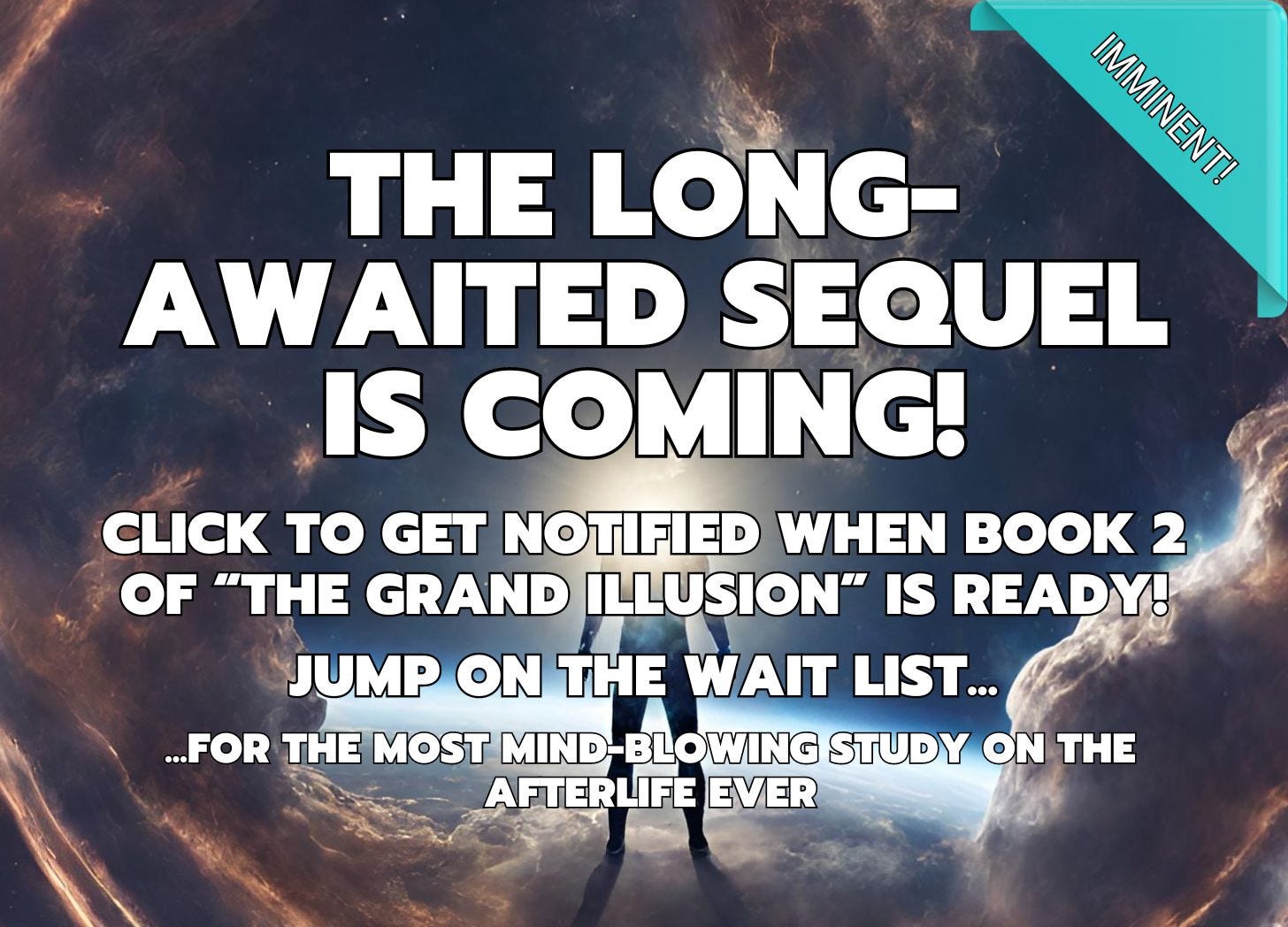Which Brain Region Creates OBEs? Questioning the Science

-
Through my Evolve Yourself program
-
Through my first book, THE GRAND ILLUSION: A SYNTHESIS OF SCIENCE & SPIRITUALITY - Book 1 📕 - 10,000 hours of research in 1 book
-
✨ Get EVERYTHING I do: Join ‘The Truthiversity - The #1 consciousness-raising university’ for all premium content (including audio versions and full podcasts - with member Q&As) for the price of barely three coffees a month! ☕️ (It’s better for your health).
In 2002 in Switzerland a huge claim was made in the field of neuroscience which received a large amount of attention. Dr Olaf Blanke and colleagues boldly announced in a paper:
"the part of the brain that can induce out-of-body experiences [OBEs] has been located"1
Blanke and co. had been working on a way to alleviate the epileptic seizures of a 43-year-old woman. Because imaging techniques failed to reveal the exact location associated with her seizures, the physicians opened her skull and electrically probed several areas to locate the defective portion, a process known as “brain mapping.”
One probe in particular stole the show: the one they used above her right temporal lobe adjacent to the angular gyrus, which is correlated with language, maths, cognition, and spatial awareness.
Stimulation of this particular electrode produced an ecsomatic experience, or so they claimed: the woman reported floating above her body and looking down at herself. Only the electrode near the angular gyrus produced the OB experience.
This all sounds hunky-dory and of course makes for great headline material—but was the study’s conclusion and logic valid?
What was the woman’s actual experience?
Did her experiences really qualify as OBEs?
To ascertain that, we need to know exactly what she experienced:
When the physicians first stimulated this area, the woman “reported that she was ‘sinking into the bed’ or ‘falling from a height.’” When they increased the electricity, she reported, “I see myself lying in bed, from above, but I only see my legs and lower trunk.” The authors reported that, “two further stimulations induced the same sensation, which included an instantaneous feeling of ‘lightness’ and ‘floating’ about two meters above the bed, close to the ceiling.”
The physicians then asked the patient to “watch her (real) legs during the electrical stimulation…This time, she reported seeing her legs ‘becoming shorter.’” The physicians went on to explain that if her legs were bent at a 90-degree angle before the stimulation, “she reported that her legs appeared to be moving quickly towards her face, and took evasive action.” The authors continued:
“When asked to look at her outstretched arms during the electrical stimulation… the patient felt as though her left arm was shortened; the right arm was unaffected. If both arms were in the same position but bent by 90 degrees at the elbow, she felt that her left lower arm and hand were moving towards her face…When her eyes were shut, she felt that her upper body was moving toward her legs, which were stable.”2 (Emphasis added)
On this basis Blanke et al. asserted, “these observations indicate that OBEs…can be artificially induced by electrical stimulation of the cortex.”
This is a huge claim to make off the back of a sample size of… 1.
As veteran NDE researchers Holden, Long, and MacLurg point out in critiquing Blanke’s paper, Blanke et al. imply that their patient’s experience
(1) fell within the definition of OBEs, and
(2) that this patient’s OBE was both representative of, and indistinguishable from, spontaneous OBEs—that it was a typical OBE.3
Holden et al. concede No. 1—that on the surface the Swiss patient’s experiences do qualify as “OBEs” according to several commonly accepted definitions (which are very generic and can lend themselves to generous interpretations).
the…authors defined OBEs as “curious, usually brief sensations in which a person’s consciousness seems to become detached from the body and take up a remote viewing position,” a definition for which they cited three European publications (Brugger, Regard, & Landis, 1997; Grusser & Landis, 1991; and Hecaen & Ajuriaguerra, 1952). American OBE researchers have offered somewhat similar definitions…4
However, any student of the field can tell you that weird perceptual distortions of physical limbs is not only NOT common in OBEs, but exceedingly UNcommon. At one point the woman saw her legs moving quickly towards her face—this is bizarre and manifestly hallucinatory.
I cannot think of a single OBE like this from all my years of reading about high strangeness (20 and counting).
On a prior stimulation she noticed her legs becoming shorter—another hallucination. Again, this type of thing is RARELY reported in the literature by people who have LUCIDLY experienced full-blown coherent OBEs.
On observing her arms she noticed her left arm shortening. More hallucination and illusion. There were others still, as documented above.
Early on, after increasing the dose of electricity, the patient reported: “I see myself lying in bed, from above, but I only see my legs and lower trunk.”
Again, this is FAR from typical of genuine OBEs. People—if they notice their typically inert physical body at all—generally see the whole thing with no parts missing and they do so in a coherent fashion, usually also noticing the surrounding environment which their WHOLE physical body is located in.
The only things her experience seems to have in common with normal lucid OBEs was her report of “sinking into the bed,” “falling from a height,” “floating close to the ceiling,” and a sense of “lightness.”
The “sinking” and “falling from a height” are explainable from an esoteric framework which the Swiss researchers would likely be unfamiliar with, but I will reserve that exposition for BOOK 2.
Suffice it to say that the feeling of sinking into the bed can sometimes precede an OBE, and “falling” from a height can perhaps be experienced upon reentry into the physical body, but these are merely fragmentary sensations being reported by Blanke—at best they might qualify as ASPECTS of a fraction of OBEs, but they certainly do not qualify as an OBE in its totality.
“Floating close to the ceiling” is really the only point where we approach what we could define as an OBE, but it is fleeting and not elaborated on. The sense of “lightness,” is also fairly common in OBEs and near-death experiences (NDEs)—but in this instance the lightness merely represents isolated, fragmentary perception.
Not doing very well so far for Team “We Found the Spot in the Brain that Causes OBEs”… 😬
New in The Truthiversity: a series about the paradigm-busting work of the HEAVILY CENSORED biologist Harold Hillman. Features: Multiple videos, papers, articles, 1 PDF book, and more. 🤙
➡️ www.truthiversity.com

In short, the woman’s experience BARELY fits the definition of an OBE, and moreover when we look at the details what we find is FAR from being representative or typical of OBEs, as Holden, Long, and MacLurg point out.
How on earth, then, could Blanke and team claim not only that their patient experienced an “OBE”, but that they had also located the “part” of the brain—the angular gyrus—“responsible” for inducing said OBE?
It is plainly just more reductionistic yearning to support an inverted worldview where consciousness is seen as epiphenomenal to matter (which readers of my work know is untrue).
Holden et al. conclude:
We believe it is inappropriate to conclude "the part of the brain that can induce out-of-body experiences has been located" (Blanke et al., p. 269) based on a single anecdotal observation, especially with the concerns we have presented. We are not aware of any other published account of the induction of purported OBE by electrostimulation of the right angular gyrus…It is possible the single anecdotal account presented by Blanke at al. was an anomalous occurrence and extremely atypical of the results of neural electrostimulation. (Emphasis added)
To further clarify things for the materialists among us, “electrostimulation of the brain has not yet yielded a typical OBE.” - Holden, Long, MacLurg
Additionally:
-
No one has produced what we recognise as consciousness from matter.
-
No one has successfully identified any part of the brain that creates consciousness, nor OBEs, NDEs, etc.
-
Even memory is increasingly seen as stored not in the brain or body but in the quantum field
Promissory materialism has failed—all the more so when we realise the “physicality” of the world itself is merely an elaborate illusion, albeit a persistent one.
The simple fact that accurate real-world information can be remotely obtained without mediation by the brain—ESPECIALLY during clinical death—obliterates any remaining credibility for materialism. Consciousness clearly exists and functions just fine without a functional physical body.
I went to great pains in BOOK 1 to demonstrate materialism’s failure and the fact that consciousness is not only NOT created by the brain or nervous system, but that it is the foundation of “reality” itself.
The evidence available blatantly disproves the foundational assumptions of philosophical materialism, and points clearly in the direction of the immortality and primacy of mind/consciousness/awareness.
If you’re interested in these subjects, you will want to read BOOK 2 when it’s available—make sure you jump on the wait list because this is a truly monumental and unique study into afterlife-related subjects.

Grab a copy of Book 1 by clicking the pic below (Brendan’s site has the lowest prices)

Some Reader Feedback
“Brendan is the Chomsky of the Spiritual movement.”
– Alobar Jones, medical intuitive
“Every person in the field of ‘paranormal’ psychology or related topics should have this book as a major reference.”
– Dr. Buryl Payne
“A masterpiece…The Grand Illusion is mind-blowing.”
– Sol Luckman, author of Potentiate Your DNA.
“You’ve written the best synthesis of modern science and esoteric science that I’ve seen in 40 years…Brilliant!”
– Michael K. Wade
🚨 For the audio + full access to ALL of my premium multimedia content become a member of The Truthiversity ⤵️



Blanke, O., Ortigue, S., Landis, T., & Seeck, M. (2002). Stimulating illusory own-body perceptions: The part of the brain that can induce out-of-body experiences has been located. Nature, 419, 269-270.
Holden, Long, MacLurg, Out-of-Body Experiences: All in the Brain?, https://www.iands.org/research/nde-research/important-research-articles/69-out-of-body-experiences-all-in-the-brain.html?showall=1
Ibid.
Ibid.


